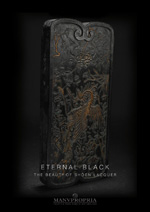Up one level
- Beryllium Copper - The new Gold?
- The Making of a #9 Ebonite Feed
- Making Nibs
- 26 Years - Angular Momentum's Métiers d'Art
- 99 Lacquer Treasures
- Kikkumon Nuri
- New Lacquer - Kin Hari Nuri (Gold Needle Lacquer)
- New Lacquer IRO KIN - Gold Colors
- How to Make a Pen Clip
- Was Sie über Urushi wissen müssen
- What to know about Urushi
- New Product - Copper & Urushi
- Urushi Glossary
- ETERNAL BLACK - The Beauty of Shôen-Lacquer
- New NEGORO Lacquer variety "Ko-Negoro"
- New Lacquer - Birdseye Maple Lacquer
- A Note on History of Lcquer
- Hikoju Makie by Takashi Wakamiya
- New Urushi Lacquer - Torukoseki Nuri
- Negoro - An Essay on Negoro, compiled by Martin Pauli
ETERNAL BLACK - The Beauty of Shôen-Lacquer
History
The history of Japanese ink (sumi) is said to have begun in 610 AD when the production methods were transmitted to Japan by a Korean monk named Damjing (Donchô in Japanese). Production of ink, essential for writing characters and recording text, moved to Nara with the relocation of the capital in the beginning of the 700s and has continued there for about 1,300 years since.
Pine Soot Ink (Shôen Zumi)
Even after the capital moved to the Kyoto area in 794, Nara remained a place of religious significance with many Buddhist temples. Much ink was needed for tasks such as sutra transcription, and there were abundant forest resources nearby to provide the carbon soot that is the ink’s raw material.
Nara, therefore remained a site of high-quality ink production. In the Nara, Heian and Kamakura periods, shôen soot from pine, which has a high resin content was the preferred material for Nara ink. This was obtained by chopping pine wood into small pieces and burning it in a stove.
Glue (Nikawa)
Besides carbon soot, the other ingredient of traditional
Japanese ink is animal-based glue (nikawa). This is extracted by boiling the dermis (the layer of skin below the epidermis) of an animal such as a cow or a deer. Nikawa is highly adhesive and is widely used as a bonding agent in traditional art forms. Sticks of ink are produced by mixing the soot with this glue and drying it. In addition, in order to ameliorate the unpleasant smell of the glue, fragrant substances such as musk, borneol or Japanese apricot blossom essence are added. This gives rise to a clean smell when the ink stick is rubbed down.
Shôen-Neri
In the old days only the finest quality lacquer ware have been lacquered with Pine Sooth Lacquer „Shôen Neri“, Urushi Lacquer mixed with Pine Sooth „Shôen Zumi“. Her the urushi serves as the strong glue for „Shôen Neri“ as „Nikawa“ for ink. While „Roiro Nuri“ Urushi Lacquer traditionally blackened with iron filings tended to turns into a brownish color with the years, „Shôen Neri“ stays black for ever.
Shôen - Pine Soot - Carbon Black
Shôen is the finest and most opaque pigment known today. The particles of the pigments measure between 30 to 80 nm only and 100% non-fading
Manu Propria‘s Shôen-Neri is made from high quality urushi mixed with natural Pine Sooth from Japan.
